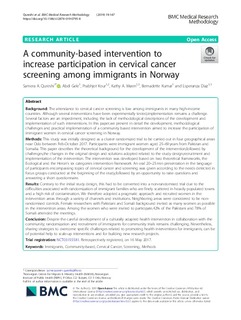| dc.contributor.author | Qureshi, Samera Azeem | |
| dc.contributor.author | Gele, Abdi | |
| dc.contributor.author | Kour, Prabhjot | |
| dc.contributor.author | Møen, Kathy Ainul Mashrooka | |
| dc.contributor.author | Kumar, Bernadette N. | |
| dc.contributor.author | Diaz, Esperanza | |
| dc.coverage.spatial | Norway | |
| dc.date.accessioned | 2019-12-20T13:32:45Z | |
| dc.date.available | 2019-12-20T13:32:45Z | |
| dc.date.created | 2019-08-14T09:39:02Z | |
| dc.date.issued | 2019 | |
| dc.identifier.citation | BMC Medical Research Methodology. 2019, 19 . | nb_NO |
| dc.identifier.issn | 1471-2288 | |
| dc.identifier.uri | http://hdl.handle.net/11250/2634324 | |
| dc.description.abstract | BACKGROUND:
The attendance to cervical cancer screening is low among immigrants in many high-income countries. Although several interventions have been experimentally tested,implementation remains a challenge. Several factors are an impediment, including the lack of methodological descriptions of the development and implementation of such interventions. In this paper,we present in detail the development, methodological challenges and practical implementation of a community based intervention aimed to increase the participation of immigrant women in cervical cancer screening in Norway.
METHODS:
This study was initially designed as a cluster randomized trial to be carried out in four geographical areas near Oslo between Feb-October 2017. Participants were immigrant women aged 25-69 years from Pakistan and Somalia. This paper describes the theoretical background for the development of the intervention,followed by challenges,the changes in the original design and solutions adopted related to the study design,recruitment and implementation of the intervention. The intervention was developed based on two theoretical frameworks, the Ecological and the Heron's six categories intervention framework. An oral 20-25 min presentation in the language of participants encompassing topics of cervical cancer and screening was given according to the needs detected in focus groups conducted at the beginning of the study,followed by an opportunity to raise questions and answering a short questionnaire.
RESULTS:
Contrary to the initial study design, this had to be converted into a non-randomised trial due to the difficulties associated with randomization of immigrant families who are finely scattered in heavily populated towns and a high risk of contamination. We therefore adopted a pragmatic approach and recruited women in the intervention areas through a variety of channels and institutions. Neighboring areas were considered to be non-randomised controls. Female researchers with Pakistani and Somali background invited as many women as possible in the intervention areas. Among the women who were invited to participate,42% of the Pakistani and 78% of Somali attended the meetings.
CONCLUSION:
Despite the careful development of a culturally adapted health intervention in collaboration with the community; randomization and recruitment of immigrants for community trials remains challenging. Nevertheless, sharing strategies to overcome specific challenges related to promoting health interventions for immigrants, can be of potential help to scale-up interventions and for building new research projects. | en |
| dc.language.iso | eng | en |
| dc.publisher | BMC | nb_NO |
| dc.rights | Navngivelse 4.0 Internasjonal | * |
| dc.rights.uri | http://creativecommons.org/licenses/by/4.0/deed.no | * |
| dc.subject | Immigrants, Community-based, Cervical Cancer, Screening, Methods | en |
| dc.title | A community-based intervention to increase participation in cervical cancer screening among immigrants in Norway | en |
| dc.type | Peer reviewed | en |
| dc.type | Journal article | en |
| dc.description.version | publishedVersion | |
| dc.rights.holder | © The Author(s). 2019 Open Access This article is distributed under the terms of the Creative Commons Attribution 4.0 International License (http://creativecommons.org/licenses/by/4.0/), which permits unrestricted use, distribution, and reproduction in any medium, provided you give appropriate credit to the original author(s) and the source, provide a link to the Creative Commons license, and indicate if changes were made. The Creative Commons Public Domain Dedication waiver (http://creativecommons.org/publicdomain/zero/1.0/) applies to the data made available in this article, unless otherwise stated. | |
| dc.source.pagenumber | 8 | nb_NO |
| dc.source.volume | 19 | nb_NO |
| dc.source.journal | BMC Medical Research Methodology | |
| dc.source.issue | 147 | nb_NO |
| dc.identifier.doi | 10.1186/s12874-019-0795-8 | |
| dc.identifier.cristin | 1715773 | |
| cristin.unitcode | 1991,0,0,0 | |
| cristin.unitname | Sykehuset Innlandet HF | |
| cristin.ispublished | true | |
| cristin.fulltext | original | |
| cristin.qualitycode | 1 | |

